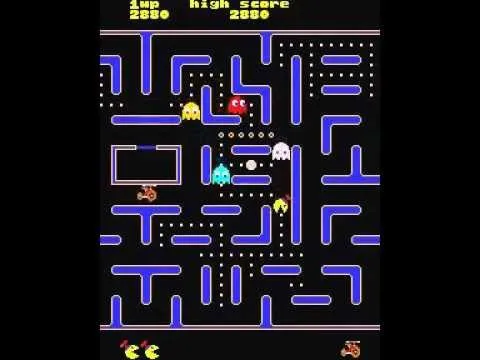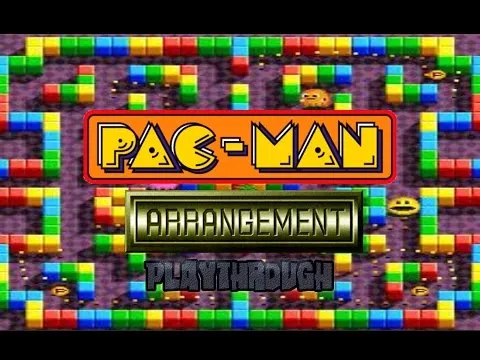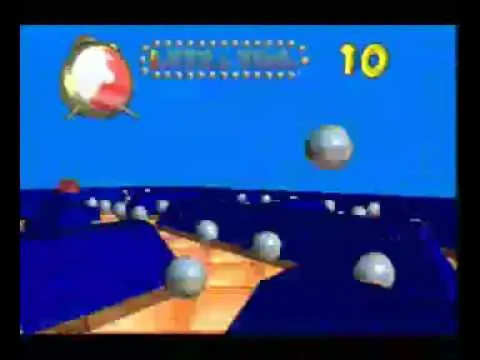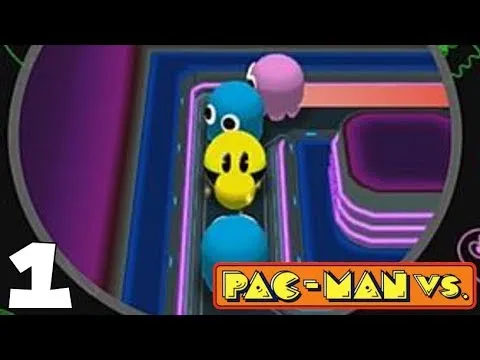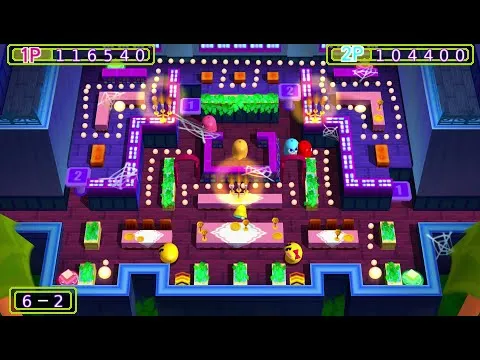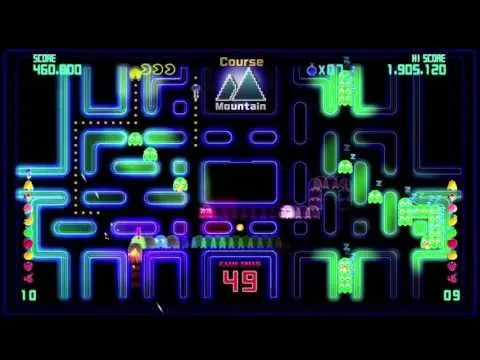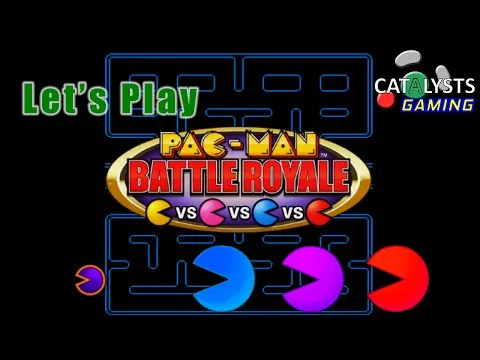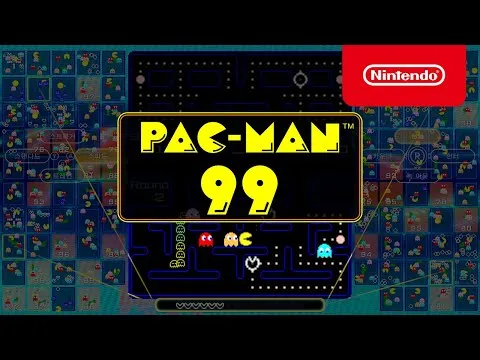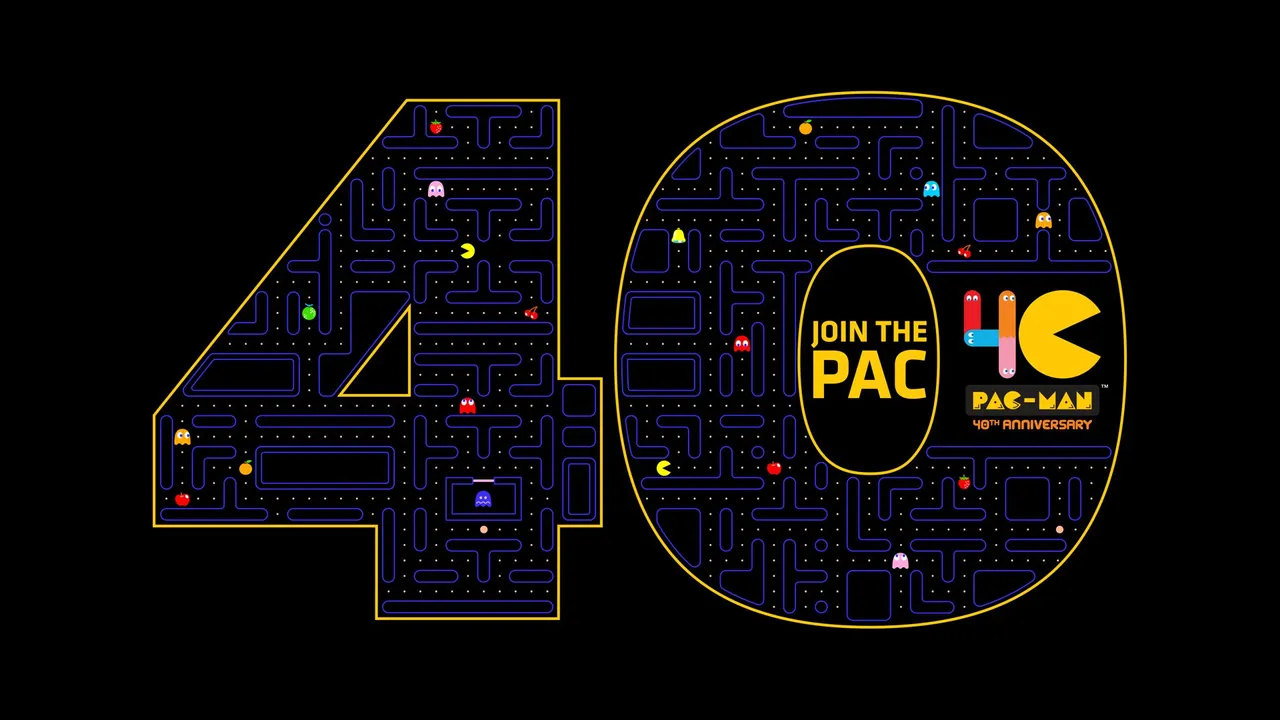
English
Pac-Man is the oldest of the big video game icons (older than Mario, Sonic, Crash, etc) as its debut game was a legendary success, and had Namco produce a lot of new games, unique spinoffs and merchandise. Even as they were developing new succesful franchises in the 90s like Ridge Racer, Tekken, Mr. Driller, Soul Calibur, Taiko no Tatsujin and so on, Pac-Man not only kept getting a stream of games along with the new franchises, but also found ways to show up in other games, like in the Mario Kart Arcade GP games (as it was co-developed by Namco), Street Fighter X Tekken (riding a giant Mokujin mech), and even as one of the many playable characters in Super Smash Bros since the Wii U/3DS entry.
With such a simple gameplay formula as running through mazes for dots and avoiding chasing ghosts working perfectly since the very first Pac-Man, any following games with the intention of adding something new to the gameplay had to be carefully creative to keep a balance between "oh, its Pac-Man!" and the new gimmick or style that the developers wanted to infuse the game with. This has led to maaaany interesting variations of Pac-Man developed over 40 years of existence (41 as of this year), and I will be talking the many, many official games that tried to reinvent this legendary game (or at least add a fun new spin on it).
Pac-Man (1980)
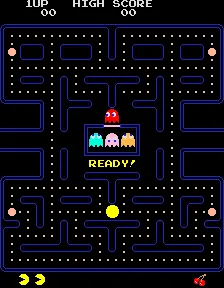
The one that started it all, one of the oldest games that has aged well in time as the simple graphics are recognizable enough and the maze chase idea can always get engaging as the speed keeps increasing on each level completed, making ghosts faster to chase you and putting your decision-making skills to test (routes, taking power-pellets or not and chasing ghosts if you do).
Ms. Pac-Man (1982)
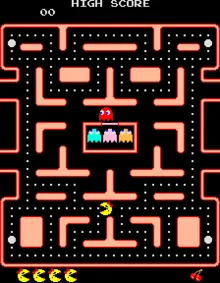
The very first sequel to Pac-Man...which interestingly had started as a bootleg called "Crazy Otto" which was purchased by Midway and repainted it as an official Pac-Man sequel (not developed by Namco but approved by them). Adding four new mazes changing after certain amount of levels and making ghosts more unpredictable (They will break and return to patterns at certain moments), it was incredibly succesful both critically and commercially.
Super Pac-Man (1982)
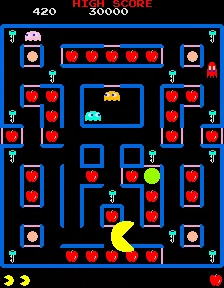
The first new Pac-Man produced that changes up the formula in a visible way, having to grab keys to open doors, and the addition of the "Super Power Pellets" (the big green dots) which makes Pac-Man go through doors without any keys, invulnerable to ghosts (though he still needs a regular one to eat them), and can go faster by holding down the new "Super Speed" button. While the rise Pac-Man's craze gave it some critical success as it was a new take on the classic dot gobbler, it wasn't as commercially succesful as Namco hoped.
Pac & Pal (1983)
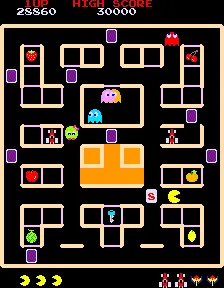
One of the biggest departures in the formula), it is based off Super Pac-Man with similar maps and items locked behind doors, but now you have to pick up cards that open specific doors, and two power-up items that let you fire beams that stun the ghosts with a button temporarily. There's also the new ghost called "Miru" (the "Pal" in the title) which can't harm you and will try to help you by taking any unlocked items into the ghost hideout, though they will disappear if she brings them there (you'll only get the item points if you grab it). While originally only released in Japan for arcades as it also failed commercially (and was not well received back in the time of its release), it was made avaliable in some few compilations and some people liked how much Namco experimented here.
Jr. Pac-Man (1983)
A game that runs with the plot of Pac-Man and Ms. Pac-Man's son, it has larger mazes horizontally (with screen scrolling), seven different mazes and not a single one of them has warp/escape tunnels on the edges. One of the simplest sequels to Pac-Man along with Ms. Pac-Man, which might not be necessarily bad considering the original Pac-Man's tried and true appeal on its gameplay.
Pac-Mania (1987)
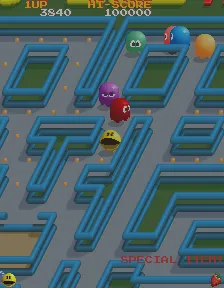
The last new Pac-Man game from the 80s (and the last arcade Pac-Man game until the next entry here), it returned to the tried-and-true original Pac-Man gameplay except with two big twists: Using an isometric view with pre-rendered 3D graphics for the game's presentation, and the ability to jump over dots and ghosts. However, on top of the 5 normal ghosts at the beginning (there's an extra purple one here), later on some green and gray ghosts will show up that always jump at the same time you do, making it impossible to jump over them and having to avoid them the old way.
Pac-Man Arrangement (Namco Classic Collection Vol. 2) (1996)
After only three Pac-Man spin-off games released between 1987 and 1996 (one of which, Pac-in-Time, is a reskinned version of another game), the arcade-only Namco Classic Collection Vol. 2 brought three new variants of old Namco games, one of them being Pac-Man. Easily one of the most creative sequels as it took advantage of the new hardware for colorful sprites, rich sound and music, and having the speed flow faster. New maps have both distinct themes and gimmicks like dash panels and jump pads, and the new ghost can be eaten at all times for a free power-pill effect...but it can also merge with other ghosts to power them up, so be careful with that! Oh, and you could play simultaneously with another player (who appeared as a Green Pac-Man) as well!
I had given a bit more of an in-depth talk of Pac-Man Arrangement additions in a previous review of Namco Classic Collection Vol.2, so you can check that out if curious about the game and the other two remixed titles.
Pac-Man VR (1996)
One of the rarest (if not the rarest) Pac-Man games ever made because of the unique setup: Avaliable in "Virtuality" systems back then, you played as Pac-Man in a first-person perspective with a headset, and while this might sound little more than a novelty with the existence of many first-person Pac-Man fangames and modern VR headsets...but this was back in 1996! Allegedly licensed by Namco, some cabinets had you move by detecting your head tilting, while others had you hold a joystick for movement. While it didn't really get to be groundbreaking in gameplay (and wasn't a success), it is still quite interesting to see this idea being tried at that time.
Pac-Man Vs. (2002)
The closest thing to a proper new Pac-Man game until 2007 was Pac-Man Vs, which was specifically made to use the Gamecube-GBA connection gimmick to turn the original Pac-Man into a multiplayer game, having the Pac-Man player take the GBA with a full view of the screen, while the other three players in Gamecube controllers have only a partial 3D-view of where they are. Competing for whoever gets a set score first, the player that caught Pac-Man while being a ghost would turn into Pac-Man, and the GBA would swap hands. While a certainly unique idea, it was physically limited by the requeriment of a GBA and a GBA-GNC cable, though the game would later get ported to the Namco Museum games on Nintendo DS and Switch.
By the way, if you happen to be curious about the topic regarding the Gamecube-GBA cable connectivity (and the few similar cases out there from this same console and other consoles), you can read a previous article I made about that topic right here.
Pac-Man Arrangement (Namco Museum Battle Collection) (PSP)
Not to be confused with the previously mentioned Arrangement from 1996, this one was featured in Namco Museum Battle Collection for the PSP, and offered another take on the classic Pac-Man with new graphics and assets, but it stuck to the original four ghosts and offers entirely different maps and themes, some of which have unique gimmicks. It also had bosses between each set of worlds, and the addition of simultaneous two-player (this time the 2nd player being Ms. Pac-Man) which sadly got cut in every version outside of PSP. There also was a "Plus" version on a Japan-exclusive compilation which changed the map visuals and apparently added four player multiplayer.
Pac-Man Championship Edition (2007)
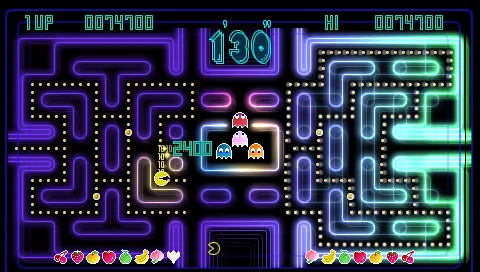
After years of spinoffs (and some few direct sequels being exclusive to compilations), Pac-Man would make a big return with Championship Edition, designed by the developers to be a modernized take with added adrenaline that yet stayed faithful to its roots and most basic elements. Released on XBLA (Xbox 360), PSN (Playstation 3), PSP and several other mobile platforms on the way, it provided several modes with different maze layouts and time-limits, and the focus shifted from just surviving as long as you can to trying to get the highest score before time runs out.
As the game exponentially increases is speed as you play it, the layouts in the left and right side on the map will change with each fruit you get, as they spawn from eating all dots in one side, and you have to find the fastest way to eat through all of them in order to keep progressing, as well as trying to take advantage of the spawning power-pellets to keep a long ghost-eating chaing for a big score bonus. A critical and commercial success and an amazingly fun take on Pac-Man, it would be the game that put him back into the spotlights.
Pac-Man Championship Edition DX (2010)
With the success of the aforementioned Championship Edition yet the potential in making a follow up, Championship Edition DX went crazy with doubling everything that the previous game had: Several great music tracks over the original game's single track, many new modes and unique mazes, and the addition of ghost trains (getting too close to a normal or sleeping ghost would cause them to start chasing you at all costs, forming a tarin) as a new danger and a way to get even more points should you grab a power-pellet to eat it. It also added something for casual players, as getting too close to a ghost would show the game in slow-motion to let you react, and the addition of bombs for getting ghosts off at any moment (but slowing down the speed).
With the DX+ update in 2013 adding extra courses and skins, along with an additional package of maps as DLC, there is a ton of content to be found in this game, easily making it my favourite Pac-Man game alongside the original Championship Edition and Arrangement (1996).
Pac-Man Battle Royale (2011)
The first Pac-Man arcade game ever since Arrangement (1996), it was another multiplayer experiment with the Pac-Man formula like in Vs, but having each player be a different-colored Pac-Man and trying to eat each other through power-pellets (turning big) and being the last one standing after each round. A fun diversion from the formula as long as you have buddies to play with, ported from arcade to Pac-Man Museum for X360, PS3 and PC.
Pac-Man 256 (2015)
Released as a free-to-play game in iOS and Android and then ported to consoles and PC without microtransactions and four-player coop, it is similar to endless runner games as you keep going on an endlessly-scrolling vertical maze, running away from "the glitch" (with this and the name itself being inspired from the Level 256 kill-screen in the original Pac-Man) and aiming for the highest score. You could also select up to 3 powerups to find on a run to assist yourself further. A good way to burn through time if outside with your phone busy with something (I say this from my own experience), and likely a fun challenge to go through in coop in home platforms.
Pac-Man Championship Edition 2 (2016)

This game changes up the already dynamic premise of the previous game by having the entire maze change instead of just one side with each fruit obtained, ghosts following a visible rail after getting a power pellet (as you have to catch them all in order to go to the next level) and being able to bump with them some few times to get them off the way (but they will get enraged if you do this and can kill you on touch).
Pac-Man Mega Tunnel Battle (2020)
Mega Tunnel Battle is another interesting multiplayer take like Vs. and Battle Royale, except that it is a literal battle royale with multiple mazes and 64 players at a time, trying to survive as the avaliable mazes keep reducing with each round (very similar to what Super Bomberman R Online does). Just like in Battle Royale, you can also eat others if you ate a power pellet, though each player has some few lives avaliable before dying. However, while this game definitely had a lot of potential to be popular in other platforms...it unfortunalely was left as an exclusive on Stadia of all things, without any ports being announced so far.
Pac-Man Championship Edition (NES Demake) (2020)
Included in the Namcot Collection compilation as a bonus, it was built off a fan's own demake of the original Championship Edition back in 2008, something that was not discovered until the new compilation was announced with a demake made by M2, though the demake officially released had better sounds and music than what was known of the 2008 version.
While it is indeed mostly a port of the original Championship Edition (though there's only a single 3 minute Extra Mode alongside the Normal mode), the noticeably increased speed of the game along with the impressive presentation ( cool soundtrack and the fact that it works on the NES of all things) made me give this version an unique spot on this list.
Pac-Man 99 (2021)
The last Pac-Man game up to this date, while similar to Mega Tunnel Battle in concept, is vastly different in many ways: The presentation is much more polished thanks to being developed directly by Namco (and comes with yet another great soundtrack, unlike MTB which doesn't even have music ingame), the mazes being based off the classic Pac-Man, and resembles Tetris 99 in that you can eat ghosts to send "jammer PAC-MAN" to other mazes that slow down players if touched (and make them easier targets for ghosts) to be the last one standing instead of going into other people's mazes. While this game is also exclusive to a single console (the Nintendo Switch), it is free to play for anyone that owns its online subscription, and looks like a blast to play!
So over the course of 40 years (and who knows what we will get from Pac-Man in this new decade), there has been a lot of ideas to come up with something that improved such an already great base of a game, either by just adding more content and gimmicks to the base formula (Ms. Pac Man, Jr. Pac-Man, Pac-Mania, both Arrangement games), trying to make something quite original or at least with different goals or experience than the usual (Super Pac-Man, Pac & Pal, Pac-Man VR, Pac-Man 256), injecting a dose of modern speed and challenge (the Pac-Man Championship Edition series)...or just experimenting with how to make Pac-Man a fun multiplayer game (Vs, Mega Tunnel Battle, Pac-Man 99...and even the Arrangement games).
At worst, some of these games might be an interesting window at how developers tried to innovate with the Pac-Man franchise through outlandish ideas and are now a part of its history, and at best, we have some more timeless gems remixed from one of the most legendary videogames ever to enjoy forever. It is great that Pac-Man never has been forgotten in time in both its impact in games and the fact that they still are fun to play today, and of course Namco could keep producing Pac-Man games occasionally as they could keep themselves afloat with their newer franchises, which will definitely deserve of their own lengthy coverage one day.
Thank you so much for reading this post! It had been a long while since the last time I got so inspired into writing this much, and really wanted to highlight several of the Pac-Man titles along history with how they tweaked a great game to make it even better. Make sure to like the post and comment below your thoughts about Pac-Man (or this post) to support me if you'd like to see more posts like this; I personally really wanted to get my creative drive back (which might have been visible back when I wrote posts with huge word counts lol) so I'm really looking forward to pushing creative content like this. See you next time!
Spanish translation with DeepL.
Español
Pac-Man es el más antiguo de los grandes iconos de los videojuegos (más que Mario, Sonic, Crash, etc.), ya que su juego de debut fue un éxito legendario, e hizo que Namco produjera una gran cantidad de nuevos juegos, spinoffs únicos y merchandising. Incluso mientras desarrollaban nuevas franquicias de éxito en los 90, como Ridge Racer, Tekken, Mr. Driller, Soul Calibur, Taiko no Tatsujin, etc., Pac-Man no solo siguió recibiendo un flujo de juegos junto con las nuevas franquicias, sino que también encontró formas de aparecer en otros juegos, como en los juegos de Mario Kart Arcade GP (ya que fue codesarrollado por Namco), Street Fighter X Tekken (montando un mech gigante Mokujin), e incluso como uno de los muchos personajes jugables en Super Smash Bros desde la entrada de Wii U/3DS.
Con una fórmula de juego tan sencilla como correr por laberintos para conseguir puntos y evitar perseguir fantasmas que funcionaba perfectamente desde el primer Pac-Man, cualquier juego posterior con la intención de añadir algo nuevo a la jugabilidad tenía que ser cuidadosamente creativo para mantener un equilibrio entre "¡oh, es Pac-Man!" y el nuevo truco o estilo que los desarrolladores querían infundir al juego. Esto ha dado lugar a un sinfín de interesantes variaciones de Pac-Man desarrolladas a lo largo de 40 años de existencia (41 hasta este año), y yo hablaré de los muchos, muchos juegos oficiales que intentaron reinventar este legendario juego (o al menos añadirle un nuevo y divertido giro).
Pac-Man (1980)

El que lo empezó todo, uno de los juegos más antiguos que ha envejecido bien en el tiempo ya que los gráficos sencillos son bastante reconocibles y la idea de la persecución en el laberinto siempre puede llegar a ser atractiva ya que la velocidad sigue aumentando en cada nivel completado, haciendo que los fantasmas te persigan más rápido y poniendo a prueba tu capacidad de decisión (rutas, coger o no pastillas de energía y perseguir a los fantasmas si lo haces).
Ms. Pac-Man (1982)

La primera secuela de Pac-Man... que curiosamente había comenzado como un bootleg llamado "Crazy Otto" que fue comprado por Midway y repintado como una secuela oficial de Pac-Man (no desarrollado por Namco pero aprobado por ellos). Añadiendo cuatro nuevos laberintos que cambian después de cierta cantidad de niveles y haciendo que los fantasmas sean más impredecibles (se romperán y volverán a los patrones en ciertos momentos), fue increíblemente exitoso tanto crítica como comercialmente.
Super Pac-Man (1982)

El primer nuevo Pac-Man producido que cambia la fórmula de manera visible, teniendo que coger llaves para abrir puertas, y la adición de los "Super Power Pellets" (los grandes puntos verdes) que hace que Pac-Man atraviese puertas sin necesidad de llaves, sea invulnerable a los fantasmas (aunque sigue necesitando uno normal para comérselos), y pueda ir más rápido manteniendo pulsado el nuevo botón "Super Speed". Aunque el auge de Pac-Man le proporcionó cierto éxito de crítica al ser una nueva versión del clásico devorador de puntos, no tuvo el éxito comercial que Namco esperaba.
Pac & Pal (1983)

Una de las mayores desviaciones de la fórmula), se basa en Super Pac-Man con mapas similares y objetos encerrados tras puertas, pero ahora tienes que recoger cartas que abren puertas específicas, y dos objetos potenciadores que te permiten disparar rayos que aturden a los fantasmas con un botón temporalmente. También está el nuevo fantasma llamado "Miru" (el "Pal" del título), que no puede hacerte daño e intentará ayudarte llevando los objetos desbloqueados al escondite de los fantasmas, aunque desaparecerán si ella los lleva allí (sólo obtendrás los puntos del objeto si lo coges). Aunque originalmente sólo se lanzó en Japón para los salones recreativos, ya que también fracasó comercialmente (y no fue bien recibido en la época de su lanzamiento), se puso a disposición en algunos recopilatorios y a algunos les gustó lo mucho que Namco experimentó aquí.
Jr. Pac-Man (1983)
Un juego que sigue la trama del hijo de Pac-Man y Ms. Pac-Man, tiene laberintos más grandes en horizontal (con desplazamiento de pantalla), siete laberintos diferentes y ni uno solo de ellos tiene túneles de deformación/escape en los bordes. Es una de las secuelas más sencillas de Pac-Man junto con Ms. Pac-Man, lo que no es necesariamente malo teniendo en cuenta el atractivo del Pac-Man original en su jugabilidad.
Pac-Mania (1987)

El último juego nuevo de Pac-Man de los años 80 (y el último juego arcade de Pac-Man hasta la siguiente entrada aquí), volvió a la probada y verdadera jugabilidad del Pac-Man original excepto con dos grandes giros: El uso de una vista isométrica con gráficos 3D pre-renderizados para la presentación del juego, y la posibilidad de saltar sobre puntos y fantasmas. Sin embargo, además de los 5 fantasmas normales del principio (aquí hay uno extra de color púrpura), más adelante aparecerán unos fantasmas verdes y grises que siempre saltan al mismo tiempo que tú, lo que hace imposible saltar sobre ellos y tener que esquivarlos a la antigua usanza.
Pac-Man Arrangement (Namco Classic Collection Vol. 2) (1996)
Después de sólo tres juegos derivados de Pac-Man lanzados entre 1987 y 1996 (uno de los cuales, Pac-in-Time, es una versión reskinned de otro juego), la Namco Classic Collection Vol. 2, sólo para recreativas, trajo tres nuevas variantes de viejos juegos de Namco, uno de ellos Pac-Man. Es sin duda una de las secuelas más creativas, ya que aprovechó el nuevo hardware para conseguir unos sprites coloridos, un sonido y una música ricos y una velocidad más rápida. Los nuevos mapas tienen tanto temas como trucos distintos, como paneles de salto y almohadillas de salto, y el nuevo fantasma puede comerse en todo momento para obtener un efecto de píldora de poder gratuita... pero también puede fusionarse con otros fantasmas para potenciarlos, ¡así que ten cuidado con eso! Ah, y también podías jugar simultáneamente con otro jugador (que aparecía como un comecocos verde).
Ya hablé un poco más en profundidad de los añadidos de Pac-Man Arrangement en un análisis anterior de Namco Classic Collection Vol.2, así que puedes echarle un vistazo si tienes curiosidad por el juego y los otros dos títulos remezclados.
Pac-Man VR (1996)
Uno de los juegos de Pac-Man más raros (si no el más raro) que se ha hecho por su configuración única: Disponible en los sistemas "Virtuality" de la época, jugabas como Pac-Man en una perspectiva en primera persona con unos auriculares, y aunque esto pueda parecer poco más que una novedad con la existencia de muchos fangames de Pac-Man en primera persona y los modernos auriculares de RV... ¡pero esto era en 1996! Supuestamente con licencia de Namco, algunas cabinas te hacían moverte detectando la inclinación de tu cabeza, mientras que otras te hacían sujetar un joystick para moverte. Aunque no llegó a ser realmente rompedor en cuanto a jugabilidad (y no fue un éxito), sigue siendo bastante interesante ver cómo se intentaba esta idea en aquella época.
Pac-Man Vs. (2002)
Lo más parecido a un nuevo juego de Pac-Man hasta 2007 fue Pac-Man Vs, que se hizo específicamente para utilizar el truco de la conexión Gamecube-GBA para convertir el Pac-Man original en un juego multijugador, haciendo que el jugador de Pac-Man lleve la GBA con una vista completa de la pantalla, mientras que los otros tres jugadores con los mandos de Gamecube sólo tienen una vista parcial en 3D de dónde están. Compitiendo por quien consiguiera primero una puntuación determinada, el jugador que atrapara a Pac-Man siendo un fantasma se convertiría en Pac-Man, y la GBA cambiaría de manos. Aunque es una idea ciertamente única, estaba limitada físicamente por el requerimiento de una GBA y un cable GBA-GNC, aunque el juego sería portado más tarde a los juegos de Namco Museum en Nintendo DS y Switch.
Por cierto, si tenéis curiosidad por el tema de la conectividad del cable Gamecube-GBA (y los pocos casos similares que hay de esta misma consola y otras), podéis leer un artículo anterior que hice sobre el tema aquí.
Pac-Man Arrangement (Namco Museum Battle Collection) (PSP)
No hay que confundirlo con el anteriormente mencionado Arrangement de 1996, éste aparecía en Namco Museum Battle Collection para la PSP, y ofrecía otra visión del clásico Pac-Man con nuevos gráficos y activos, pero se ceñía a los cuatro fantasmas originales y ofrecía mapas y temas totalmente diferentes, algunos de ellos con trucos únicos. También tenía jefes entre cada conjunto de mundos, y la adición de dos jugadores simultáneos (esta vez el segundo jugador era Ms. Pac-Man), que lamentablemente se eliminó en todas las versiones fuera de PSP. También hubo una versión "Plus" en un recopilatorio exclusivo para Japón que cambiaba las imágenes de los mapas y, al parecer, añadía el modo multijugador para cuatro jugadores.
Pac-Man Championship Edition (2007)

Tras años de spinoffs (y algunas pocas secuelas directas exclusivas de recopilaciones), Pac-Man regresaría a lo grande con Championship Edition, diseñado por los desarrolladores para ser una toma modernizada con adrenalina añadida que, sin embargo, se mantenía fiel a sus raíces y elementos más básicos. Lanzado en XBLA (Xbox 360), PSN (Playstation 3), PSP y otras plataformas móviles en camino, ofrecía varios modos con diferentes diseños de laberintos y límites de tiempo, y el foco de atención pasó de ser simplemente sobrevivir el mayor tiempo posible a intentar conseguir la mayor puntuación antes de que el tiempo se agotara.
Como el juego aumenta exponencialmente su velocidad a medida que se juega, los trazados de los lados izquierdo y derecho del mapa cambian con cada fruta que consigues, ya que aparecen al comer todos los puntos de un lado, y tienes que encontrar la forma más rápida de comer a través de todos ellos para seguir progresando, así como intentar aprovechar las bolitas de poder que aparecen para mantener un largo cauce de comer fantasmas para conseguir una gran bonificación de puntuación. Un éxito comercial y de crítica, y una versión increíblemente divertida de Pac-Man, que sería el juego que lo volvería a poner en el candelero.
Pac-Man Championship Edition DX (2010)
Con el éxito del ya mencionado Championship Edition pero con el potencial en hacer una continuación, Championship Edition DX se volvió loco con doblar todo lo que tenía el juego anterior: Varias pistas musicales geniales sobre la única pista del juego original, muchos modos nuevos y laberintos únicos, y la adición de los trenes fantasma (acercarse demasiado a un fantasma normal o durmiente hacía que empezara a perseguirte a toda costa, formando un tarín) como nuevo peligro y forma de conseguir aún más puntos en caso de coger una pastilla de energía para comérsela. También se añadió algo para los jugadores casuales, ya que acercarse demasiado a un fantasma mostraría el juego en cámara lenta para permitirte reaccionar, y la adición de bombas para sacar a los fantasmas en cualquier momento (pero ralentizando la velocidad).
Con la actualización DX+ en 2013 que añadió campos y skins extra, junto con un paquete adicional de mapas como DLC, hay una tonelada de contenido que se puede encontrar en este juego, convirtiéndolo fácilmente en mi juego favorito de Pac-Man junto con el original Championship Edition y Arrangement (1996).
Pac-Man Battle Royale (2011)
El primer juego arcade de Pac-Man desde Arrangement (1996), fue otro experimento multijugador con la fórmula de Pac-Man como en Vs, pero teniendo cada jugador un Pac-Man de diferente color y tratando de comerse unos a otros a través de power-pellets (volviéndose grandes) y siendo el último en pie después de cada ronda. Un divertido desvío de la fórmula siempre que tengas amigos con los que jugar, portado de arcade a Pac-Man Museum para X360, PS3 y PC.
Pac-Man 256 (2015)
Lanzado como un juego free-to-play en iOS y Android y luego portado a consolas y PC sin microtransacciones y coop para cuatro jugadores, es similar a los juegos endless runner ya que sigues en un laberinto vertical de desplazamiento infinito, huyendo del "glitch" (con esto y el propio nombre inspirado en la pantalla de muerte del nivel 256 en el Pac-Man original) y buscando la mayor puntuación. También podías seleccionar hasta 3 potenciadores para encontrar en una carrera para ayudarte más. Una buena forma de quemar el tiempo si estás fuera con el teléfono ocupado en algo (lo digo por experiencia propia), y probablemente un reto divertido para recorrer en coop en plataformas caseras.
Pac-Man Championship Edition 2 (2016)

Este juego cambia la ya dinámica premisa del juego anterior haciendo que todo el laberinto cambie en lugar de sólo un lado con cada fruta obtenida, que los fantasmas sigan una barandilla visible después de conseguir una bolita de poder (ya que hay que atraparlos a todos para pasar al siguiente nivel) y pudiendo chocar con ellos algunas veces para quitarlos del camino (pero se enfurecen si lo haces y pueden matarte al tocarlos).
Pac-Man Mega Tunnel Battle (2020)
Mega Tunnel Battle es otro interesante multijugador como Vs. y Battle Royale, excepto que es un battle royale literal con múltiples laberintos y 64 jugadores a la vez, intentando sobrevivir mientras los laberintos disponibles se van reduciendo con cada ronda (muy similar a lo que hace Super Bomberman R Online). Al igual que en Battle Royale, también puedes comerte a los demás si comes una bolita de poder, aunque cada jugador tiene algunas pocas vidas disponibles antes de morir. Sin embargo, aunque este juego tenía mucho potencial para ser popular en otras plataformas... lamentablemente quedó como una exclusiva en Stadia de todas las cosas, sin que se haya anunciado ningún puerto hasta ahora.
Pac-Man Championship Edition (Demake de NES) (2020)
Incluido en el recopilatorio Namcot Collection como extra, fue construido a partir de un demake propio de un fan del Championship Edition original allá por 2008, algo que no se descubrió hasta que se anunció el nuevo recopilatorio con un demake realizado por M2, aunque el demake lanzado oficialmente tenía mejores sonidos y música que lo que se conocía de la versión de 2008.
Si bien es cierto que se trata en su mayor parte de un port de la Championship Edition original (aunque solo hay un Modo Extra de 3 minutos junto al modo Normal), el notable aumento de la velocidad del juego junto con la impresionante presentación (la genial banda sonora y el hecho de que funcione en la NES de todas las cosas) me han hecho dar a esta versión un lugar único en esta lista.
Pac-Man 99 (2021)
El último juego de Pac-Man hasta la fecha, si bien es similar a Mega Tunnel Battle en cuanto a concepto, es enormemente diferente en muchos aspectos: La presentación está mucho más pulida gracias a haber sido desarrollado directamente por Namco (y viene con otra gran banda sonora, a diferencia de MTB que ni siquiera tiene música ingame), los laberintos están basados en el clásico Pac-Man, y se asemeja a Tetris 99 en que puedes comer fantasmas para enviar "jammer PAC-MAN" a otros laberintos que ralentizan a los jugadores si los tocan (y los convierten en objetivos más fáciles para los fantasmas) para ser el último en pie en lugar de entrar en los laberintos de los demás. Aunque este juego también es exclusivo de una sola consola (la Nintendo Switch), es gratuito para cualquiera que posea su suscripción online, ¡y parece una pasada jugarlo!
Así que en el transcurso de 40 años (y quién sabe lo que obtendremos de Pac-Man en esta nueva década), ha habido un montón de ideas para llegar a algo que mejorara una base tan grande de un juego, ya sea sólo añadiendo más contenido y trucos a la fórmula base (Ms. Pac Man, Jr. Pac-Man, Pac-Mania, los dos juegos Arrangement), intentando hacer algo bastante original o al menos con objetivos o experiencia diferentes a los habituales (Super Pac-Man, Pac & Pal, Pac-Man VR, Pac-Man 256), inyectando una dosis de velocidad y desafío modernos (la serie Pac-Man Championship Edition)... o simplemente experimentando cómo hacer de Pac-Man un divertido juego multijugador (Vs, Mega Tunnel Battle, Pac-Man 99... e incluso los juegos Arrangement).
En el peor de los casos, algunos de estos juegos pueden ser una interesante ventana a cómo los desarrolladores intentaron innovar con la franquicia Pac-Man a través de ideas extravagantes y ahora forman parte de su historia, y en el mejor de los casos, tenemos algunas joyas más atemporales remezcladas de uno de los videojuegos más legendarios de la historia para disfrutarlas siempre. Es genial que Pac-Man nunca haya sido olvidado en el tiempo, tanto en su impacto en los juegos como en el hecho de que todavía son divertidos de jugar hoy en día, y por supuesto Namco podría seguir produciendo juegos de Pac-Man de vez en cuando, ya que podrían mantenerse a flote con sus franquicias más nuevas, que definitivamente merecerán su propia cobertura larga algún día.
¡Muchas gracias por leer este post! Ha pasado mucho tiempo desde la última vez que me inspiré para escribir tanto, y realmente quería destacar varios de los títulos de Pac-Man a lo largo de la historia con la forma en que ajustaron un gran juego para hacerlo aún mejor. Asegúrate de darle a "me gusta" a la entrada y de comentar debajo tu opinión sobre Pac-Man (o sobre esta entrada) para apoyarme si te gustaría ver más entradas como esta; personalmente, tenía muchas ganas de recuperar mi impulso creativo (que podría haber sido visible cuando escribía entradas con un enorme número de palabras, lol), así que tengo muchas ganas de impulsar contenido creativo como este. ¡Hasta la próxima!
Traducción al español hecha con DeepL.
